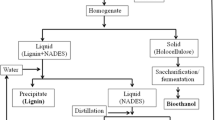Abstract
Immobilized Candida tropicalis cells in freeze dried calcium alginate beads were used for production of xylitol from lignocellulosic waste like corn cob hydrolysate without any detoxification and sterilization of media. Media components for xylitol fermentation were screened by statistical methods. Urea, KH2PO4 and initial pH were identified as significant variables by Plackett–Burman (PB) design. Significant medium components were optimized by response surface methodology (RSM). Predicted xylitol yield by RSM model and experimental yield was 0.87 and 0.79 g/g, respectively. Optimized conditions (urea 1.5 g/L, KH2PO4 1.9 g/L, xylose 55 g/L, pH 6.7) enhanced xylitol yield by 32% and xylose consumption by twofold over those of basal media. In addition, the immobilized cells were reused five times at shake flask level with optimized medium without affecting the xylitol productivity and yield. Xylitol production was successfully scaled up to 7.5 L stirred tank reactor using optimized media. Thus, the optimized condition with non-detoxified pentose hydrolysate from corn cob lignocellulosic waste with minimal nutrients without any sterilization opens up the scope for commercialization of the process.





Similar content being viewed by others
References
Affleck RP (2000) Recovery of xylitol from fermentation of model hemicellulose hydrolysates using membrane technology. M.Sc. thesis, Virginia Polytechnic Institute and State University, Blacksburg, Virginia
Cao NJ, Tang R, Gong CS, Chen LF (1994) The effect of cell density on the production of xylitol from d-xylose by yeast. Appl Biochem Biotechnol 45(1):515–519
Carla JSM, Roberto IC (2001) Optimization of xylitol production by Candida guillermondii FTI 20037 using response surface methodology. Process Biochem 36:1119–1124
Champagne CP, Blahuta N, Brion F, Gagnon C (2000) A vortex-bowl disk atomizer system for the production of alginate fermentor. Biotechnol Bioeng 68:681–688
Gu XB, Zheng ZM, Yu HQ, Wang J, Liang FL, Liu RL (2005) Optimization of medium constituents for a novel lipopeptide production by Bacillus subtilis MO-01 by a response surface method. Process Biochem 40:3196–3201
Jirku V, Masák J, Cejková A (2000) Yeast cell attachment: a tool modulating wall composition and resistance to 5-bromo-6-azauracil. Enzyme Microb Technol 26:808–811
Ling H, Cheng K, Ge J, Ping W (2011) Statistical optimization of xylitol production from corncob hemicellulose hydrolysate by Candida tropicalis HDY-02. New Biotechnol 28(6):673–678
Pal S, Joshi S, Padmanabhan S, Rao R, Kumbhar P (2013) Preparation of lignocellulosic hydrolysate (2053/MUM/2013)
Pepper T, Olinger PM (1988) Xylitol in sugar free confections. Food Technol 10:98–106
Plackett RL, Burman JP (1946) The design of optimum multifactorial experiments. Biometrika 33:305–325
Povelainen M (2008) Pentitol phosphate dehydrogenases: discovery, characterization and use in d-arabitol and xylitol production by metabolically engineered Bacillus subtilis. Ph.D. Dissertation, University of Helsinki, Helsinki, Finland
Rajagopalan S, Yewale T, Ingle U, Panchwagh S, Wavikar M, Patil H, Shaikh I, Ahmed F (2014) A process for the preparation of xylitol from natural xylose (1908/MUM/2014). http://ipindiaonline.gov.in/patentsearch/GrantedSearch/viewdoc.aspx?id=81afBGvBut7aK+RCzbjhgw%3d%3d&loc=vsnutRQWHdTHa1EUofPtPQ%3d%3d. Accessed 20 Apr 2017
Rivas B, Domínguez JM, Domínguez H, Parajó JC (2002) Bioconversion of post hydrolysed auto hydrolysis liquors: an alternative for xylitol production from corn cobs. Enzyme Microb Technol 31(4):431–438
Roberto C, Felipe MGA, Lacis LS, Silva SS, Mancilha IM (1991) Utilisation of sugar cane bagasse hemicellulosic hydrolysate by Candida guillermondii for xylitol production. Bioresour Technol 36:271–275
Sluiter A, Ruiz R, Scarlata C, Sluiter J, Templeton D (2008a) Determination of extractives in biomass. Laboratory Analytical Procedure (LAP), National Renewable Energy Laboratory (NREL). http://www.nrel.gov/docs/gen/fy08/42619.pdf. Accessed 19 Apr 2017
Sluiter A, Hames B, Ruiz R, Scarlata C, Sluiter J, Templeton D, Crocker D (2008b) Determination of structural carbohydrates and lignin in biomass. Laboratory Analytical Procedures (LAP), National Renewable Energy Laboratory (NREL). http://www.nrel.gov/docs/gen/fy13/42618.pdf. Accessed 19 Apr 2017
Sluiter A, Hames B, Ruiz R, Scarlata C, Sluiter J, Templeton D (2008c) Determination of ash in biomass. Laboratory Analytical Procedures (LAP). National Renewable Energy Laboratory (NREL). http://www.nrel.gov/docs/gen/fy08/42622.pdf. Accessed 19 Apr 2017
Tran LH, Yogo M, Ojima H, Idota O, Kawai K, Suzuki T (2004) The production of xylitol by enzymatic hydrolysis of agricultural wastes. Biotechnol Bioprocess Eng 9:223–228
Uhari M, Kontiokari T, Koskela M, Niemelä M (1996) Xylitol chewing gum in prevention of acute otitis media: double blind randomized trial. BMJ 313:1180–1184
Yewale T, Panchwagh S, Rajagopalan S, Dhamole P, Jain R (2016) Enhanced xylitol production using immobilized Candida tropicalis with non-detoxified corn cob hemicellulosic hydrolysate. 3 Biotech 6(1):1–10
Ylikahri R (1979) Metabolic and nutritional aspect of xylitol. Adv Food Res 25:159–180
Acknowledgements
The author acknowledges the analytical team of Praj Matrix for experimental sample analysis and Siddhartha Pal for providing xylose hydrolysate stream.
Author information
Authors and Affiliations
Corresponding author
Ethics declarations
Conflict of interest
The authors declare that they have no conflict of interest in the publication.
Electronic supplementary material
Below is the link to the electronic supplementary material.
Rights and permissions
About this article
Cite this article
Yewale, T., Panchwagh, S., Sawale, S. et al. Xylitol production from non-detoxified and non-sterile lignocellulosic hydrolysate using low-cost industrial media components. 3 Biotech 7, 68 (2017). https://doi.org/10.1007/s13205-017-0700-2
Received:
Accepted:
Published:
DOI: https://doi.org/10.1007/s13205-017-0700-2




